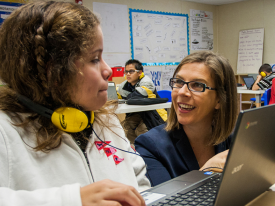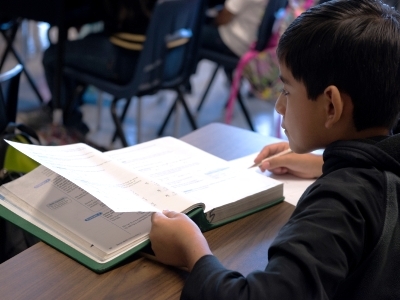Ending the Digital Divide is Key to Educational Equity
Topics

Together, educators are doing the reimagining and reinvention work necessary to make true educational equity possible. Student-centered learning advances equity when it values social and emotional growth alongside academic achievement, takes a cultural lens on strengths and competencies, and equips students with the power and skills to address injustice in their schools and communities.
Technology offers the promise and ability to help close achievement, but when utilized in current K-12 infrastructure, the result increases the performance gap.
Educators across America are struggling to answer the same question: how do we responsibly and equitably integrate technology into our classrooms? There is a wide range of opinions among teachers and instructional designers. On one end of the spectrum are visions of creating teaching environments straight out of a sci-fi novel, where AI robots interact with students. At the opposite end is the stark reality of antiquated classrooms devoid of technology, where the pencil still rules. But teachers at all levels no longer have a choice when it comes to incorporating technology-driven learning solutions for their students. In today’s world, techno-literacy is no less vital than traditional literacy and numeracy.
States are increasing funding for online interventions and other educational tools for student use. Unfortunately, these investments often fail to deliver the promised results due to the digital divide. Student records such as grades are now primarily available online, and parents without internet access lack the needed oversight to help ensure their child’s success. Providing connectivity is essential to getting parents more involved in their student’s education, particularly in our most vulnerable communities.
Everyone agrees that access to technology is essential to academic success and prepares students to navigate an increasingly technology-driven world. However, our current infrastructure is inequitable. The U.S. has the highest-priced internet access in the world, which is too expensive for nearly 10 percent of families. Public access points across the nation such as libraries are closing doors to due to budgetary concerns. Schools face tough financial decisions, and building adequate infrastructure often comes with a steep price tag. Older schools face the increased cost of retrofitting today’s technology and become a patchwork of quick fixes, leading to reliability issues. Teachers in these schools are hesitant to include technology due to the likelihood of connectivity issues and failure. Expanding technology use in education on the existing infrastructure will magnify the current inequities and widen performance gaps among students. Ensuring all students have internet access is vital to closing these gaps and teaching students the desired skills for tomorrow.
Access is not a cheap problem to solve, and schools cannot address the concern alone. We must invest in reliable IT infrastructure for every school and community. Solutions such as Lifeline, which helps provide discounted internet connectivity, have not been effective. These programs are poorly advertised, mostly through the local schools, and have cumbersome enrollment processes and usage restrictions. And in 2017, the FCC began pulling support for Lifeline, removing the few incentives ISPs had to offer discounted internet access.
Programs such as Lifeline must not rely on ISPs for participation due to conflict with profit motives. Schools and teachers are best suited to help direct resources to address connectivity concerns. Proactively offering these programs to parents as part of student registrations would increase participation and the success of these programs. Funding programs to provide internet access at home must be a legislative priority at both the federal and state levels.
Internet access must be viewed as an essential utility. We have the technology to ensure access for all students. Now we must commit resources and develop policies that end the digital divide. As educators, we must advocate for the prioritization of legislation that supports the funding and implementation of targeted programs to ensure all students have internet access. Additionally, we need to dynamically embrace the distinct position of schools as resources within our communities. The failure to close the digital divide will widen performance gaps in education and rob students of the skills vital for tomorrow.




